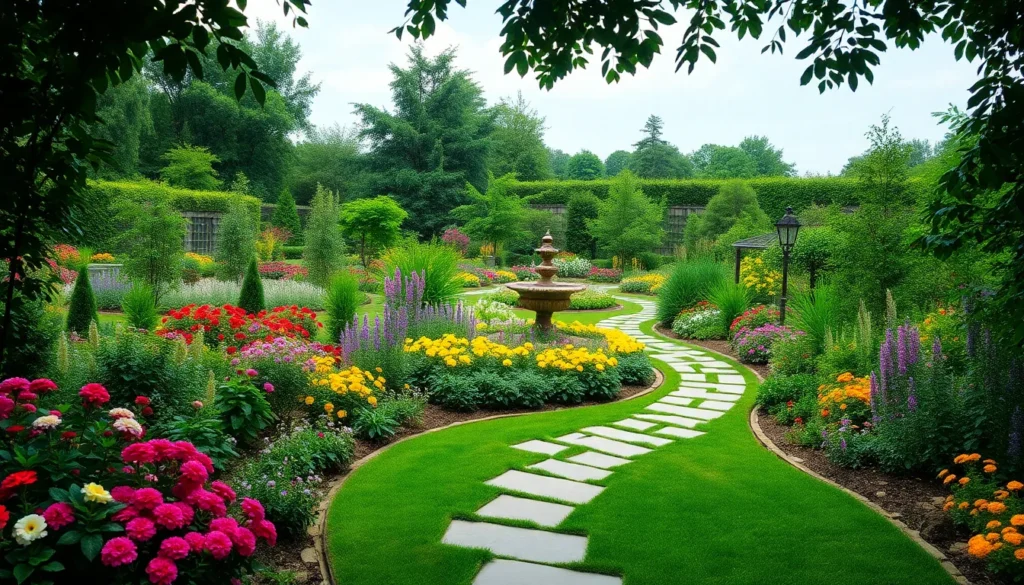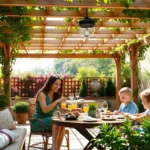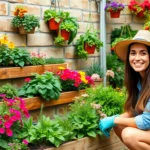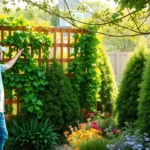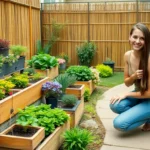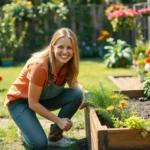When we’re blessed with a sprawling outdoor space, the possibilities feel both exciting and overwhelming. Large gardens offer incredible opportunities to create stunning landscapes that combine beauty with functionality, but knowing where to start can feel daunting.
We’ve discovered that the key to maximizing a large garden lies in strategic planning and creative zoning. Whether you’re dreaming of expansive flower beds, productive vegetable patches, or entertaining areas that’ll make your neighbors envious, the right approach transforms even the most intimidating space into your personal paradise.
The best part? Large gardens give us the freedom to experiment with bold design elements that simply won’t fit in smaller spaces. From dramatic focal points to meandering pathways that create mystery and intrigue, we can create outdoor experiences that rival professional botanical gardens while staying within realistic budgets and maintenance schedules.
Create Distinct Garden Zones for Different Activities
Large gardens offer incredible opportunities to create specialized areas that serve different purposes throughout your outdoor space. We’ll explore how to establish three essential zones that maximize both functionality and visual appeal.
Designate a Vegetable Garden Area
Positioning your vegetable garden in the sunniest spot ensures optimal growing conditions for most crops. We recommend choosing an area that receives 6-8 hours of direct sunlight daily and has easy access to water sources.
Raised beds work exceptionally well for large vegetable gardens since they provide better drainage and soil control. We suggest creating beds that are 4 feet wide and 8-12 feet long, allowing you to reach the center from either side without stepping on the soil.
Companion planting maximizes your harvest by grouping vegetables that benefit each other naturally. We’ve found that tomatoes thrive alongside basil, while carrots grow well near onions and lettuce. This strategic placement also helps with natural pest control and soil nutrition.
Succession planting extends your growing season by staggering plantings every 2-3 weeks. We plant lettuce, radishes, and beans in small sections throughout spring and summer to ensure continuous harvests rather than overwhelming abundance all at once.
Establish a Flower Garden Section
Perennial borders create lasting structure in your flower garden while providing years of blooms with minimal replanting. We design these borders using the “thriller, filler, spiller” concept with tall plants like delphiniums in back, medium height hostas in middle, and ground cover plants like creeping phlox in front.
Color coordination enhances visual impact through thoughtful planning of bloom times and color combinations. We suggest creating a color wheel plan that includes complementary colors like purple and yellow or analogous colors like blues, purples, and pinks for harmonious displays.
Seasonal interest keeps your flower garden attractive year round through strategic plant selection. We incorporate spring bulbs, summer perennials, fall chrysanthemums, and winter evergreens to ensure something catches the eye in every season.
Native plant selections support local ecosystems while requiring less maintenance and water. We choose indigenous flowers like coneflowers, black-eyed Susans, and native grasses that attract beneficial insects and birds while thriving in local climate conditions.
Build a Relaxation and Entertainment Zone
Patio placement maximizes usability by considering sun patterns, privacy, and accessibility from your home. We recommend positioning patios to receive morning sun but afternoon shade, creating comfortable spaces for both breakfast and evening gatherings.
Outdoor kitchen elements transform your entertainment zone into a functional cooking space. We suggest incorporating a grill station, prep counter, and storage areas using weather resistant materials like natural stone or concrete that complement your garden’s aesthetic.
Seating arrangements accommodate different group sizes through flexible furniture placement and varied seating options. We create conversation areas using a mix of built in benches, moveable chairs, and casual seating like outdoor cushions or hammocks.
Privacy screens define your relaxation space while maintaining an open feel throughout the garden. We use living screens like bamboo, ornamental grasses, or trellised vines rather than solid fences to create intimate areas without blocking sightlines completely.
Lighting extends usability into evening hours through strategic placement of ambient and task lighting. We install pathway lights for safety, string lights for ambiance, and spotlights to highlight key garden features while creating a magical nighttime atmosphere.
Install Water Features as Focal Points
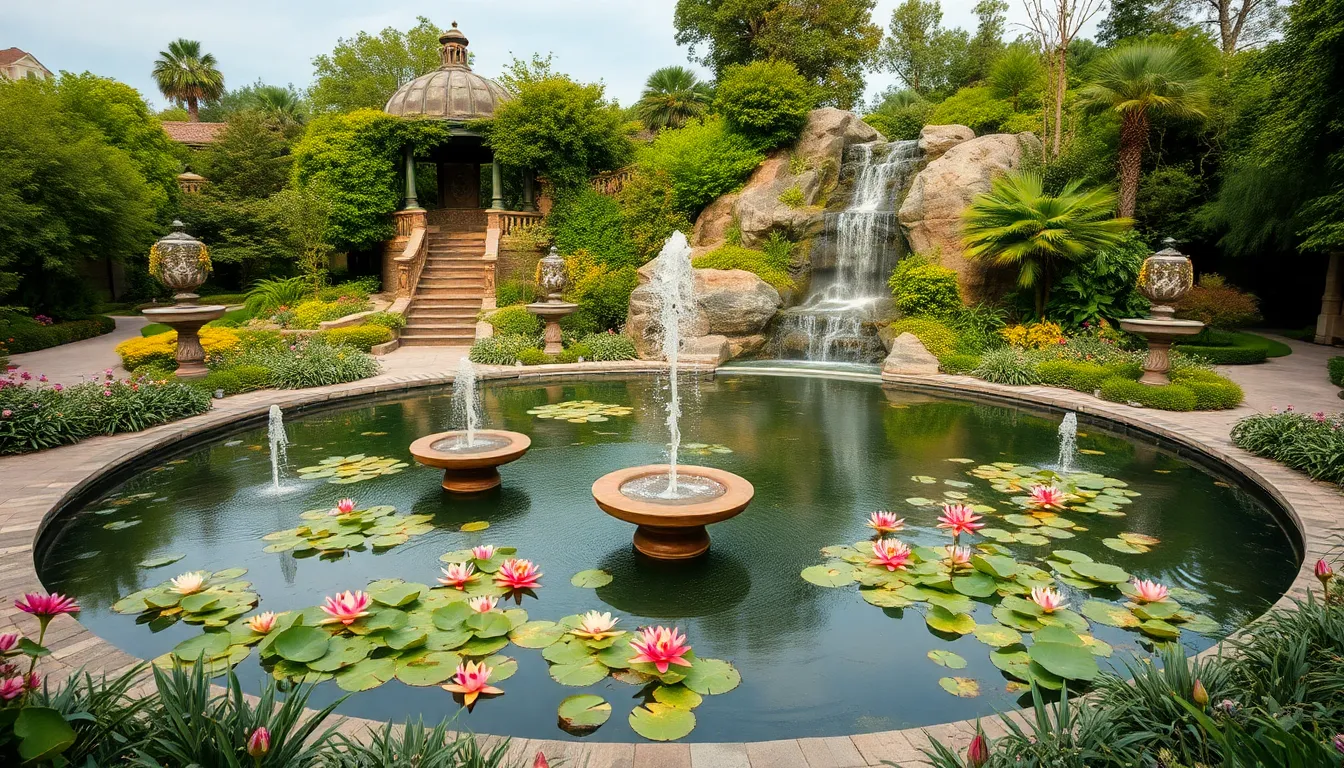
Water features transform large gardens into stunning outdoor sanctuaries that captivate the senses. We’ll explore three dramatic options that can serve as commanding centerpieces for your expansive industry.
Add a Large Pond or Lake
Large ponds or lakes create the most impactful focal points for spacious gardens. We recommend positioning these important water features centrally to maximize their visual influence throughout your outdoor space. Natural swimming holes work beautifully when designed with organic shapes that mirror existing industry contours.
Walking paths around your pond’s perimeter enhance accessibility while creating multiple viewing angles. Decorative docks extend into the water, providing intimate spaces for contemplation or morning coffee. Aquatic plants like water lilies and cattails establish habitat for local wildlife while softening harsh edges.
Strategic lighting transforms nighttime pond experiences into magical displays. Underwater LED systems illuminate swimming fish, while perimeter fixtures cast gentle reflections across the water’s surface. Small islands within larger ponds add dimensional interest without overwhelming the design.
Create Multiple Fountain Installations
Multiple fountains throughout your garden establish ever-changing focal points that draw visitors deeper into the industry. We suggest varying fountain heights and styles to create visual rhythm without monotony. Tiered fountains work particularly well near formal entertaining areas, while single jet fountains complement modern design schemes.
Spacing fountains strategically prevents sound overlap while ensuring each installation commands its designated area. Corner placements in garden rooms create intimate water sounds without overwhelming conversation. Central courtyard positions work best for larger spray patterns that cool surrounding air during summer months.
Different materials like natural stone, cast concrete, or metal create unique aesthetic experiences. Programmable fountain systems allow seasonal adjustments to water height and timing patterns. Solar powered options reduce operational costs while maintaining consistent water movement throughout daylight hours.
Design Cascading Waterfall Systems
Cascading waterfall systems deliver the most dramatic water feature experiences for large gardens. We design these installations to flow naturally from elevated positions, creating multiple viewing opportunities as water descends through various levels. Natural rock formations work best when integrated with existing topography rather than appearing artificially placed.
Series of connected pools allow water to pause and reflect light before continuing its downward journey. Each cascade level offers unique planting opportunities for moisture loving specimens like ferns and hostas. Sound variety emerges from different drop heights and pool depths throughout the system.
Recirculating pumps ensure continuous water flow while maintaining consistent water levels across all cascade elements. Hidden plumbing preserves natural aesthetics while providing reliable mechanical operation. Seasonal plantings around waterfall edges create changing displays that complement the permanent water feature structure.
Design Expansive Lawn Areas for Recreation
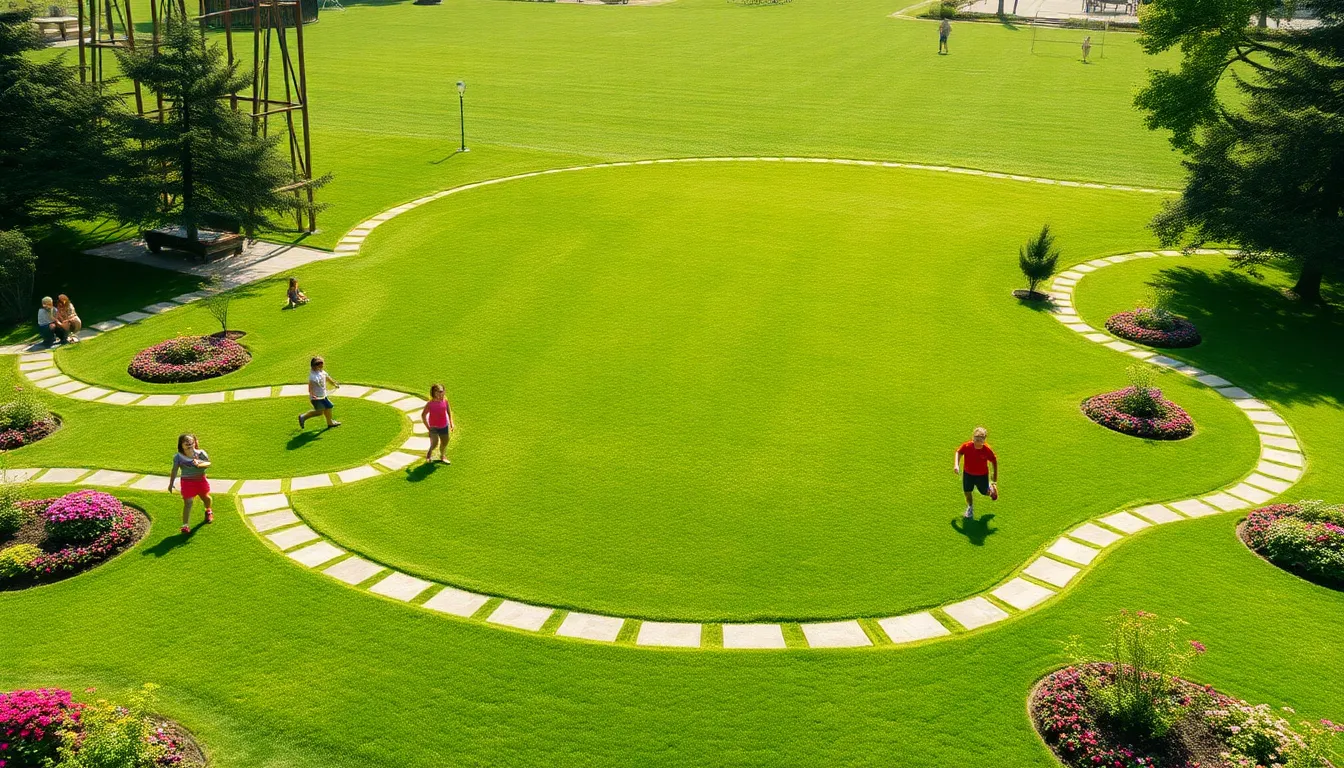
Large gardens provide us with the perfect opportunity to create stunning recreational spaces that serve multiple purposes throughout the year. We can transform these open areas into the heart of our outdoor living experience.
Plan Open Grass Spaces for Activities
Open grass spaces become the foundation for countless outdoor activities when we design them with versatility in mind. We should allocate substantial portions of our large garden to create uninterrupted lawn areas that can accommodate sports like soccer, frisbee, or cricket during active times.
Planning these spaces requires us to consider traffic patterns and seasonal usage throughout the year. We can designate exact zones for different activities, such as a level area for outdoor dining and entertaining, while reserving sloped sections for more casual play activities.
Accessibility plays a crucial role in our lawn design, so we need to ensure pathways connecting to these spaces are wide enough for maintenance equipment and wheelchair access. We should maintain clear sightlines across our lawn areas to enhance safety and create an inviting atmosphere for gatherings and events.
Create Curved Pathways Through the Lawn
Curved pathways transform our expansive lawns from simple grass areas into captivating industry experiences that guide visitors through different garden zones. We can use these meandering routes to create visual interest and encourage exploration while connecting various recreational areas seamlessly.
Material selection for our pathways significantly impacts both aesthetics and functionality across large garden spaces. We should consider durable options like natural stone, brick pavers, or decorative gravel that complement our garden’s overall design while withstanding heavy foot traffic and weather conditions.
Strategic pathway placement allows us to highlight focal points and create natural gathering spots throughout our lawn areas. We can incorporate gentle curves that follow the natural contours of our industry, making maintenance easier while adding visual appeal that draws the eye across our expansive garden space.
Install Irrigation Systems for Large Areas
Efficient irrigation systems become essential for maintaining healthy grass across our expansive lawn areas without excessive water waste or labor intensive manual watering. We need to carry out comprehensive sprinkler systems that provide even coverage while adapting to different zones within our large garden space.
Smart irrigation technology offers us the ability to automate watering schedules based on weather conditions, soil moisture levels, and seasonal requirements. We can install sensors throughout our lawn areas that adjust water delivery automatically, ensuring optimal growing conditions while conserving resources and reducing maintenance time.
Zone based irrigation design allows us to customize water delivery for different areas of our lawn based on sun exposure, grass type, and usage patterns. We should create separate irrigation zones for high traffic recreational areas that may need more frequent watering compared to decorative lawn sections that require less intensive maintenance.
Build Substantial Hardscaping Elements
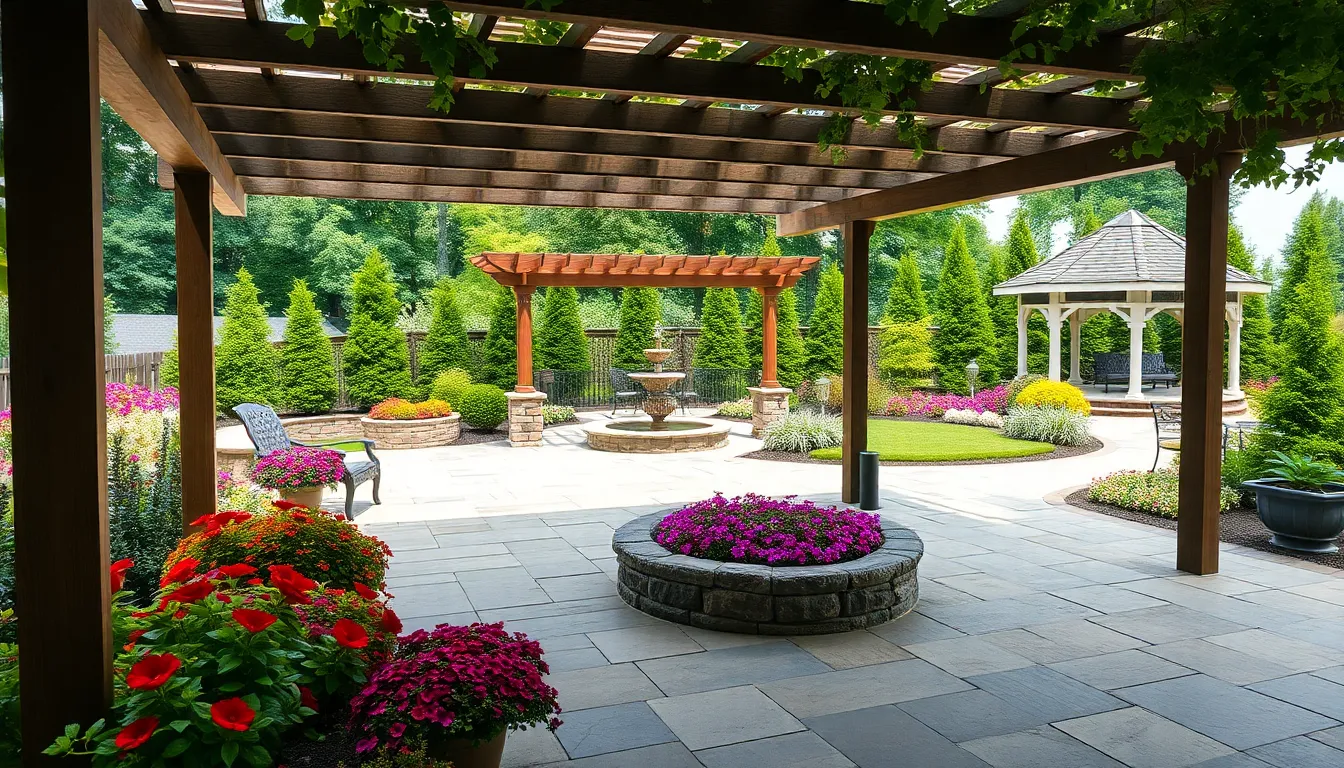
Substantial hardscaping elements provide the structural foundation that transforms large gardens from simple green spaces into sophisticated outdoor living environments. These permanent features create functional zones while adding visual weight and architectural interest to expansive landscapes.
Construct Stone Patios and Terraces
Stone patios and terraces create essential gathering spaces that serve as outdoor rooms for dining, entertaining, and relaxation. We recommend using durable materials like bluestone, flagstone, or brick to construct these expansive surfaces that can withstand heavy foot traffic and weather conditions.
Multi-level designs work exceptionally well in large gardens, allowing us to take advantage of natural elevation changes while creating distinct activity zones. Flagstone offers natural beauty with its varied colors and textures, while brick provides classic appeal and easy maintenance. Concrete pavers deliver modern aesthetics with consistent sizing and professional installation results.
Strategic placement of outdoor furniture and decorative elements enhances both functionality and visual appeal of these hardscaped areas. We suggest incorporating built-in seating, planters, and sculptural features to create cohesive design themes that complement the surrounding industry.
Install Pergolas and Gazebos
Pergolas create stunning overhead structures that define outdoor spaces while providing partial shade and support for climbing plants. These versatile installations work beautifully as shaded walkways connecting different garden areas or as standalone features over dining and seating zones.
Material selection significantly impacts both durability and aesthetic appeal of these structures. Wood pergolas offer natural warmth and blend seamlessly with garden settings, while metal options provide modern styling and exceptional longevity with minimal maintenance requirements.
Gazebos serve as dramatic focal points that provide fully covered retreat spaces within large garden settings. We position these structures to take advantage of scenic views while creating intimate gathering spots for conversation and relaxation. Strategic placement near water features or flower gardens maximizes their visual impact and functional value.
Create Retaining Walls for Elevation Changes
Retaining walls solve practical drainage and erosion issues while creating opportunities for dramatic terraced garden designs. Stone, brick, and concrete construction materials each offer distinct advantages for managing elevation changes and creating separate garden levels throughout large landscapes.
Proper construction techniques ensure these walls provide long-term stability while improving the garden’s overall aesthetic appeal. We integrate plantings and shrubs along wall surfaces to soften their appearance and create natural transitions between different garden zones.
Drainage considerations remain critical for retaining wall success, preventing water buildup that could compromise structural integrity. Strategic placement of these walls creates opportunities for raised planting beds, seating areas, and cascading garden designs that maximize the visual impact of elevation changes.
Plant Trees for Structure and Privacy
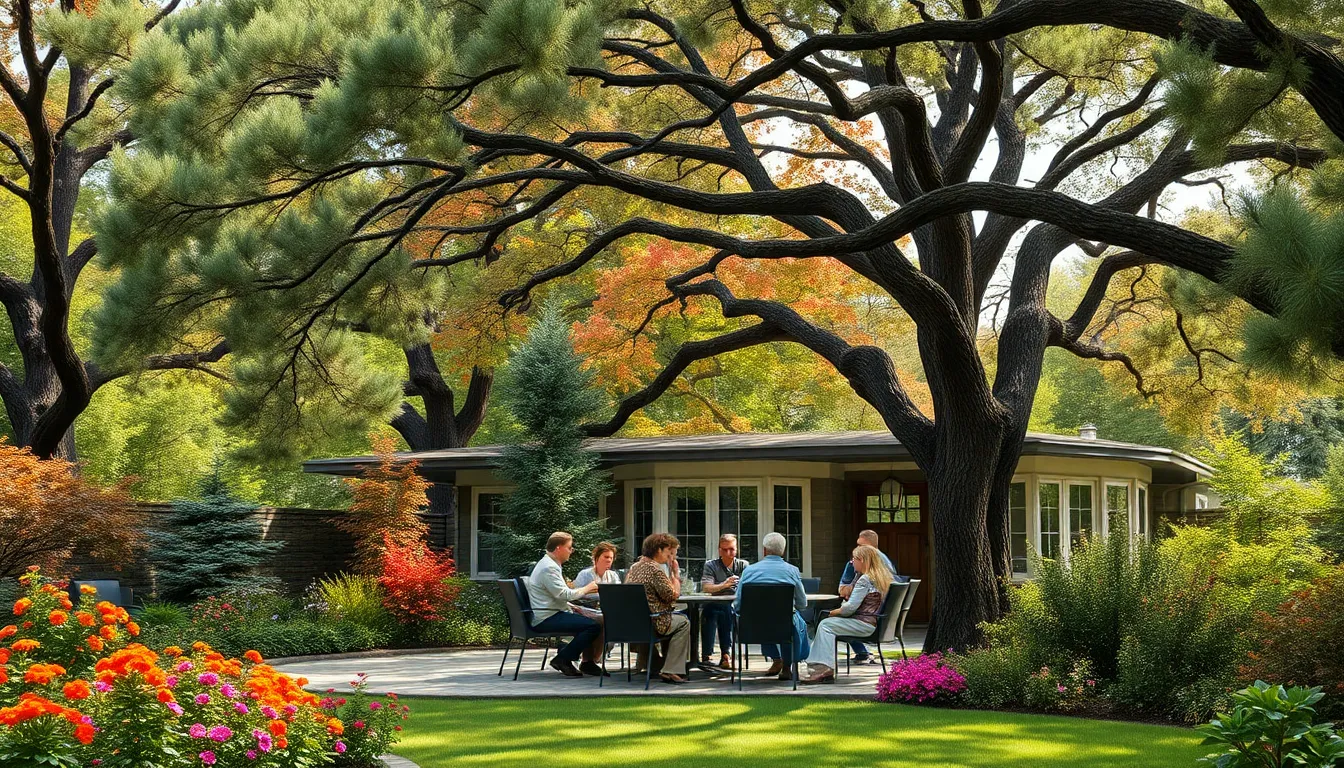
Strategic tree placement transforms large gardens into cohesive outdoor environments. We’ll create natural boundaries and establish the foundational framework that defines our garden’s character.
Select Large Shade Trees as Anchors
Large shade trees function as the backbone of our garden design, providing both practical benefits and visual structure. Oak trees offer decades of reliable shade while creating magnificent canopies that frame outdoor seating areas. Maple varieties deliver stunning seasonal color changes alongside their cooling properties during summer months.
Pine trees establish year-round presence with their evergreen foliage and distinctive architectural forms. We position these anchor trees strategically to create natural gathering points around patios and lawn areas. Their mature canopies define separate garden zones while offering relief from intense sunlight.
Consider the ultimate size of each species when planning our layout. Sugar maples can reach 60-75 feet in height, making them perfect centerpieces for expansive lawns. Red oaks develop broad spreading crowns that complement large scale hardscaping elements like stone terraces and pergolas.
Create Natural Privacy Screens
Evergreen trees and shrubs form living walls that shield our garden from neighboring properties and busy streets. Arborvitae creates dense, uniform barriers that maintain their screening effect throughout all seasons. We plant these privacy trees in staggered rows to achieve fuller coverage while avoiding the rigid appearance of single-file installations.
Eastern white pine grows quickly to establish privacy screens within just a few years of planting. Their soft needles and graceful branching patterns soften harsh property lines while providing complete visual blocking. Leyland cypress offers another fast-growing option that tolerates various soil conditions and climate zones.
We incorporate native evergreen shrubs like mountain laurel or rhododendron beneath taller privacy trees. This layered approach creates more complete screening while adding textural interest at different heights. The combination of trees and shrubs ensures privacy remains intact even during winter months when deciduous plants lose their leaves.
Design Seasonal Interest with Diverse Species
Diverse plant species ensure our large garden maintains visual appeal throughout every season of the year. We select trees that bloom at different times to create continuous waves of color and interest. Spring flowering trees like cherry, dogwood, and magnolia provide early season drama before summer perennials reach their peak.
Fall foliage trees extend our garden’s beauty well into autumn months with brilliant red, orange, and yellow displays. Sugar maples deliver intense orange-red colors while oak trees transition to rich bronze and russet tones. We position these seasonal performers where they’ll be visible from indoor living spaces and outdoor entertaining areas.
Winter interest comes from trees with distinctive bark patterns, persistent fruits, or striking silhouettes. Birch trees offer white bark that creates stunning contrast against snow and evergreen backgrounds. Crabapple varieties provide colorful fruits that attract birds while adding pops of red or orange to winter landscapes.
Strategic placement allows us to view seasonal changes from different vantage points throughout our garden. We create sight lines that showcase spring blossoms from morning coffee spots and autumn colors from evening gathering areas.
Establish Themed Garden Sections
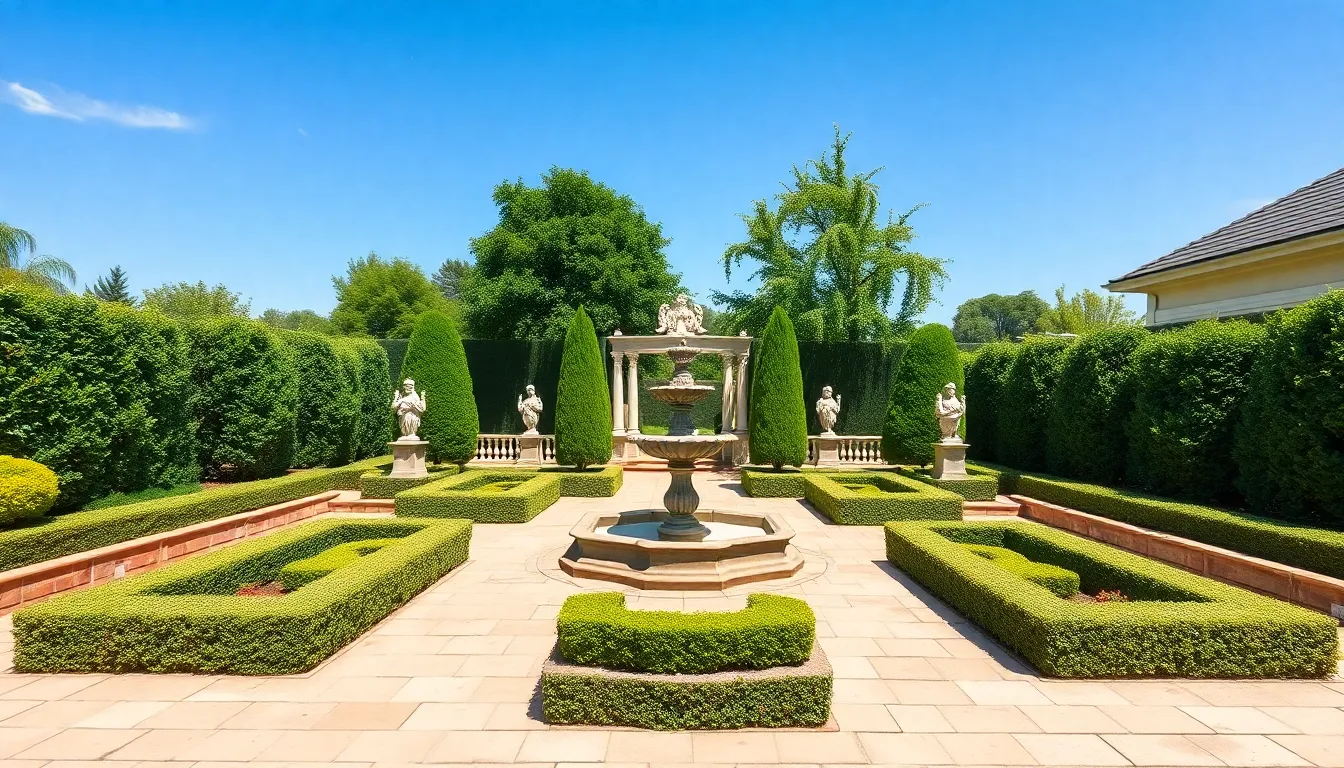
Themed garden sections transform large outdoor spaces into distinct experiences that serve different purposes and appeal to various senses. We’ll explore three compelling approaches that maximize visual impact while creating functional outdoor rooms.
Design a Formal Garden Area
Formal gardens bring timeless elegance to large spaces through structured design principles that create sophisticated outdoor environments. We recommend establishing symmetrical layouts using raised beds positioned at equal distances from central pathways or focal points.
Symmetrical elements form the backbone of formal garden design, with geometric patterns created through carefully planned plantings and hardscaping features. Balanced arrangements of shrubs like boxwood or privet define borders and create clean lines that guide the eye throughout the space.
Strategic focal points anchor formal sections using elements like ornamental statues, large specimen trees, or decorative urns positioned at pathway intersections. Central fountains or sundials serve as commanding centerpieces that draw visitors deeper into the designed space.
Raised bed structures elevate plantings while providing better drainage and soil control for vegetables, herbs, or flowers arranged in precise patterns. Rectangular or square configurations work best for maintaining the geometric aesthetic that defines formal garden styles.
Create a Wildflower Meadow Section
Wildflower meadows offer low maintenance beauty while supporting local ecosystems through natural planting approaches. We suggest dedicating substantial portions of large gardens to these sustainable sections that change dramatically with seasonal cycles.
Native plant selections ensure better survival rates and reduced water requirements compared to non indigenous species. Regional wildflowers like black eyed susans, purple coneflowers, and native grasses create authentic meadow environments that thrive without extensive intervention.
Minimal maintenance requirements make wildflower sections ideal for busy homeowners who want maximum visual impact with reduced upkeep demands. Annual mowing in late fall and occasional overseeding provide sufficient care for healthy meadow establishment.
Enhanced biodiversity results from wildflower plantings that attract beneficial insects, butterflies, and birds throughout growing seasons. Natural pollinator habitats develop organically within meadow sections, supporting local wildlife populations while reducing pest problems in other garden areas.
Build a Rock Garden Display
Rock gardens provide dramatic visual interest while accommodating challenging growing conditions that limit other planting options. We recommend incorporating varied stone sizes and textures to create natural looking alpine environments within larger garden designs.
Diverse rock selections include boulders, medium stones, and smaller gravel arranged to mimic natural mountain slopes or creek beds. Limestone, sandstone, and granite offer different colors and textures that complement various plant combinations and garden themes.
Specialized plant choices thrive in well draining rocky conditions, including succulents like sedums, alpine perennials, and dwarf conifers that add year round structure. These hardy selections require minimal water once established and provide continuous visual appeal through changing seasons.
Thoughtful design layouts incorporate stone pathways that wind through rock garden sections, creating opportunities for close up plant observation and garden exploration. Elevated plantings between rock crevices showcase individual specimens while maintaining natural drainage patterns essential for rock garden success.
Incorporate Outdoor Living Spaces
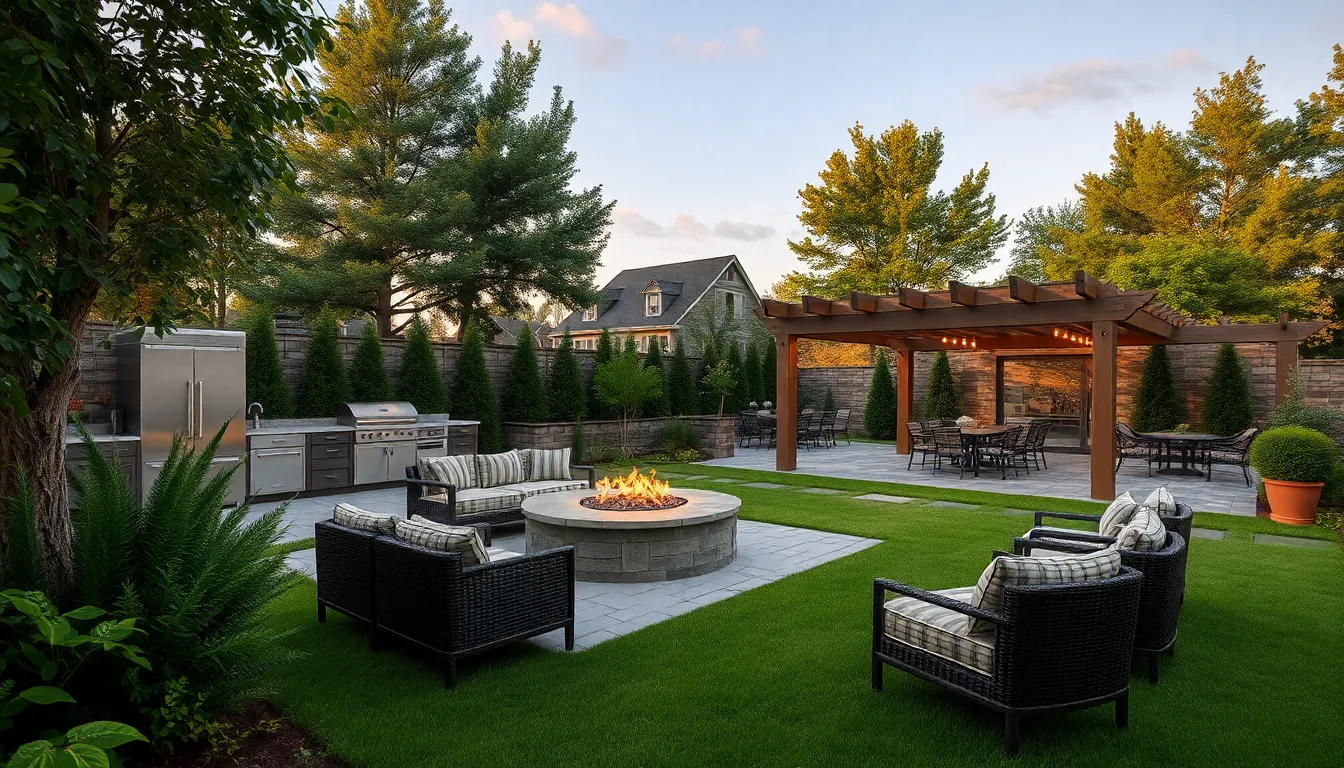
Transform your expansive garden into a true extension of your home by incorporating outdoor living spaces that invite relaxation and entertainment throughout the seasons.
Install Fire Pits and Outdoor Kitchens
Fire pits create cozy gathering spots that extend your outdoor season well into cooler evenings. Position them strategically away from overhanging branches and structures, allowing for comfortable seating circles that encourage conversation. Stone or metal fire pits work particularly well in large gardens, providing both warmth and dramatic focal points.
Outdoor kitchens elevate your garden entertaining to restaurant quality experiences. Design your outdoor kitchen with essential elements like grills, countertops, and built in seating to help seamless al fresco dining. Include weatherproof storage for utensils and outdoor dinnerware, making your garden kitchen as functional as your indoor space.
Create Multiple Seating Areas
Bench seating along walkways and under established trees provides multiple relaxation spots throughout your garden journey. Place benches at scenic viewpoints or near water features to maximize their impact and usage. Built in stone benches offer permanent answers that complement your hardscaping elements.
Seating nooks with comfortable outdoor furniture and surrounding lush greenery create intimate spaces for quiet contemplation. Design these areas with weather resistant cushions and side tables for beverages or books. Screen these intimate spaces with tall plants or decorative panels to enhance privacy.
Design Outdoor Dining Spaces
Al fresco dining areas transform your garden into an elegant restaurant setting with properly sized outdoor tables and chairs for casual dining experiences. Choose furniture materials that withstand weather conditions while maintaining style and comfort. Position dining areas near your outdoor kitchen for convenient food service.
Covered dining spaces provide essential shade and weather protection for year round outdoor meals. Add pergolas or gazebos over your dining areas to create defined spaces that feel intimate even though your garden’s large scale. Install outdoor ceiling fans or heating elements to extend the usability of these covered areas across different seasons.
Add Functional Storage and Work Areas
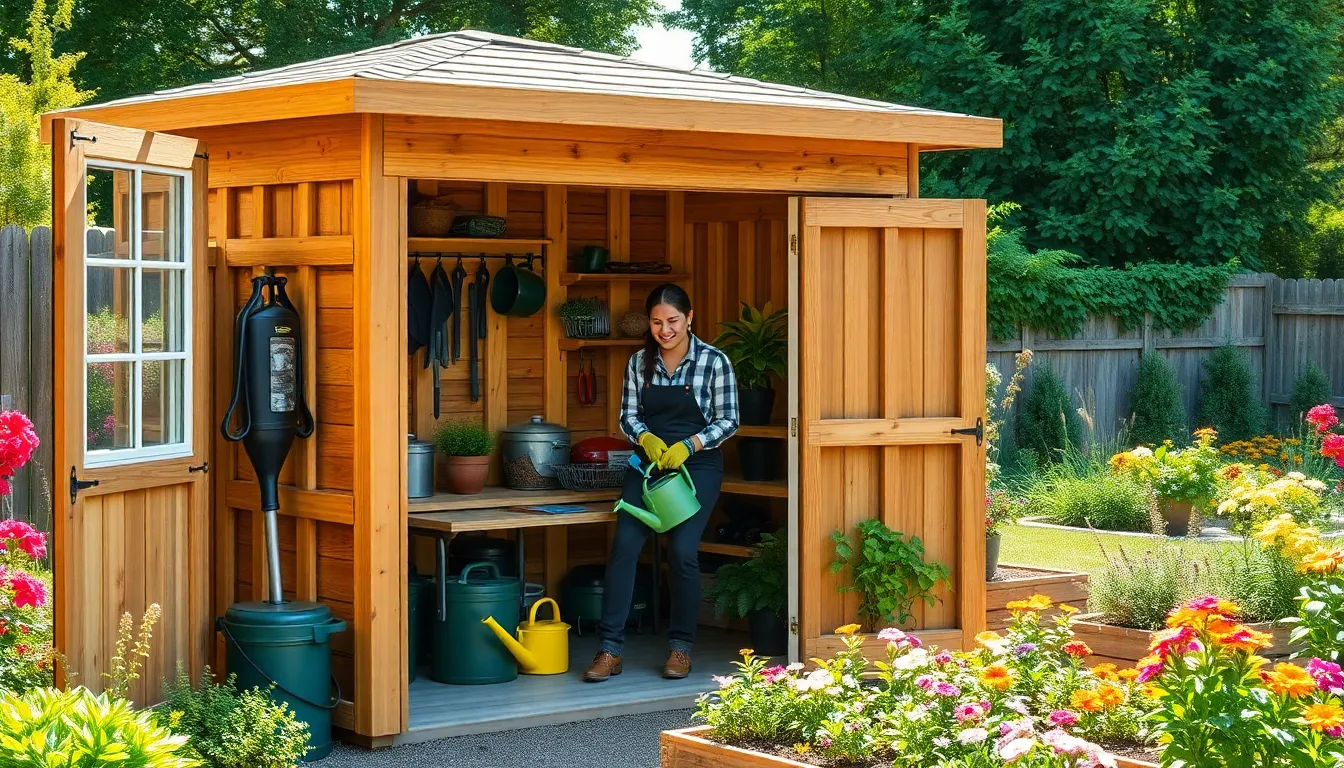
Large gardens require practical answers to keep tools organized and work spaces efficient. We’ll transform your outdoor space with dedicated areas that combine functionality with aesthetic appeal.
Build Garden Sheds and Tool Storage
Garden sheds serve as essential command centers for our large outdoor spaces, providing dedicated storage for gardening tools and equipment. We recommend positioning these structures in easily accessible locations while ensuring they complement our garden’s overall design aesthetic.
Design considerations play a crucial role in maximizing shed functionality and visual appeal. Determining the shed’s primary purpose—whether storage focused or workspace oriented—guides our size and layout decisions. Windows add natural light to workspace areas, making potting and tool maintenance more enjoyable throughout the day.
Tool organization systems transform cluttered sheds into efficient work centers. Wall mounted racks maximize vertical storage space while keeping frequently used items within easy reach. Cabinets and toolboxes create designated spots for smaller implements, seeds, and garden supplies.
Weather resistant materials ensure our investment withstands seasonal changes and heavy use. We suggest incorporating adequate ventilation to prevent moisture buildup and protect stored equipment from rust and deterioration.
Create Composting Areas
Compost bins convert organic waste into nutrient rich soil amendments while reducing household waste streams. We strategically position these systems in areas that balance accessibility with discretion, ensuring easy maintenance without compromising our garden’s visual appeal.
Layout planning involves selecting spots away from main living areas to minimize potential odors during active decomposition phases. Multiple bin systems allow us to rotate compost stages, maintaining continuous soil production for our expansive garden beds.
Three bin configurations work exceptionally well for large gardens, accommodating fresh materials, active composting, and finished compost simultaneously. We recommend using cedar or recycled plastic construction materials that resist weathering while maintaining attractive appearances.
Proper drainage prevents waterlogged compost piles that develop unpleasant anaerobic conditions. Adding gravel bases or raised platforms ensures adequate air circulation while protecting surrounding industry areas from excess moisture.
Design Greenhouse Spaces
Greenhouse installations extend growing seasons and provide controlled environments for starting seedlings and overwintering tender plants. We position these structures to capture maximum sunlight exposure while protecting them from harsh winter winds.
Ventilation systems regulate temperature and humidity levels essential for healthy plant growth throughout changing seasons. Automatic vent openers respond to temperature fluctuations, maintaining optimal growing conditions without constant manual adjustments.
Shelving arrangements maximize growing space within greenhouse footprints while accommodating plants of varying heights and growth habits. Tiered systems create microclimates suitable for different plant families and growth stages.
Irrigation integration simplifies plant care routines and ensures consistent moisture levels during extended absences. Drip systems and misting installations deliver precise water amounts while preventing overwatering issues common in enclosed growing environments.
Foundation options include permanent concrete pads for year round structures or gravel bases for seasonal greenhouse installations. We recommend professional electrical installation for heating systems, grow lights, and automated ventilation controls.
Plan Seasonal Color Displays
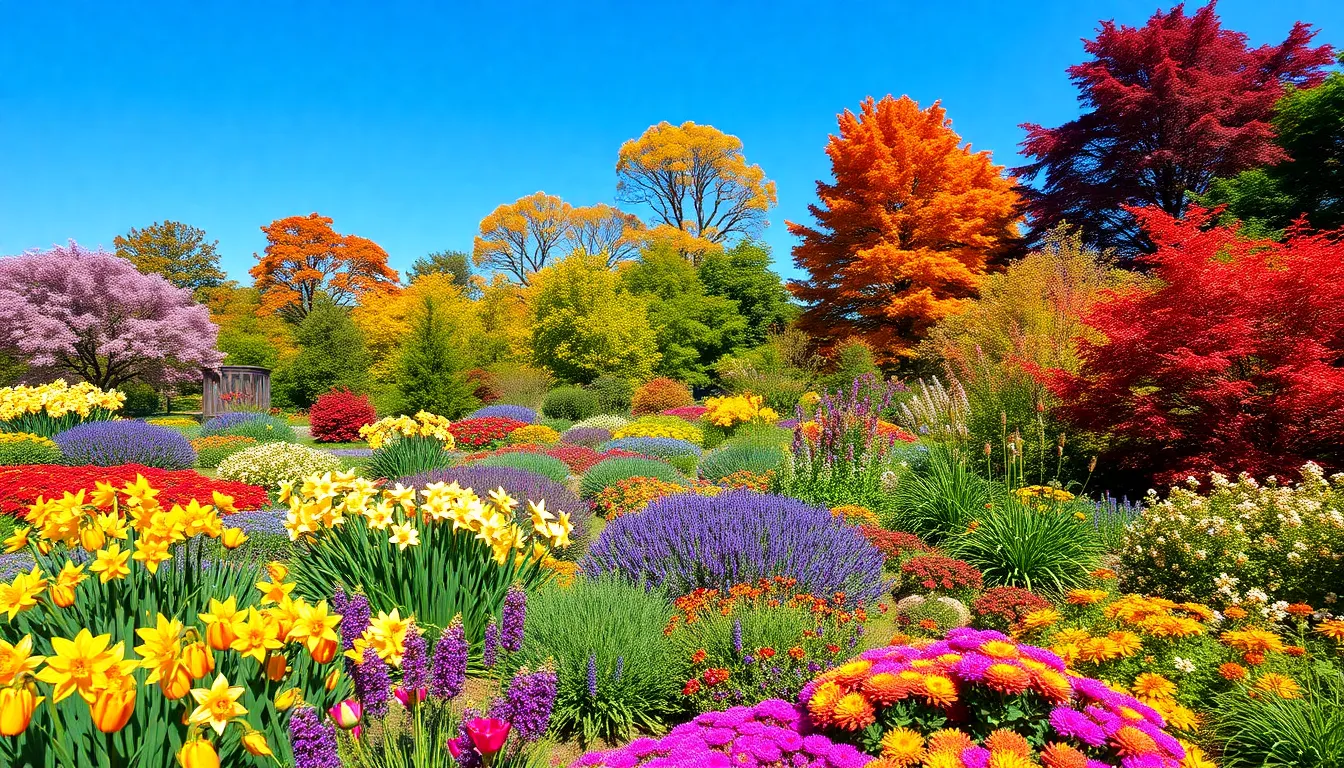
Creating year-round visual interest in large gardens requires strategic plant selection that provides continuous color throughout each season. We’ll maximize our garden’s potential by incorporating plants with different seasonal blooms and foliage to maintain captivating displays from spring through winter.
Design Spring Bulb Gardens
Plant early-blooming bulbs like daffodils and hyacinths in the fall to create stunning spring displays. These critter-resistant bulbs provide the first bursts of color after winter’s dormancy, awakening our garden with vibrant yellows, purples, and whites. We recommend grouping bulbs in clusters of 10-15 for maximum visual impact rather than scattering individual bulbs throughout the space.
Layer bulb plantings with perennials that emerge later in spring to create extended interest. This technique ensures continuous coverage as tulips and crocuses fade, while hostas and astilbe begin their growth cycles. We achieve this by planting bulbs 6-8 inches deep with perennial companions positioned around them at proper spacing intervals.
Combine different bulb varieties with staggered bloom times to extend the spring color season. Early bloomers like snowdrops and winter aconite start the show in late winter, followed by daffodils in early spring, then tulips and alliums in mid to late spring. This succession creates 8-10 weeks of continuous spring color in large garden displays.
Create Summer Perennial Borders
Arrange summer-flowering perennials like irises and Joe Pye weed in layered formations for maximum visual impact. We position tall plants such as shrubs and bamboo at the back of borders, followed by mid-sized perennials and ornamental grasses, then finish with shorter shrubs and ground covers at the front. This creates depth and ensures all plants receive adequate light exposure.
Incorporate pollinator-friendly plants like lavender and coneflowers to enhance biodiversity while maintaining vibrant summer color. These selections attract beneficial insects and butterflies while providing continuous blooms from June through September. We space these plants 18-24 inches apart to allow for mature growth and air circulation.
Select perennials with complementary bloom times to ensure continuous color throughout the summer months. Early summer performers like peonies and lupines transition to mid-summer stars such as daylilies and bee balm, followed by late-summer champions including sedum and asters. This planning creates 16-20 weeks of uninterrupted summer garden displays.
Plan Fall Foliage Areas
Choose trees and shrubs with brilliant autumn foliage like maples and oaks to create spectacular fall focal points. These deciduous specimens transform large garden spaces with fiery reds, golden yellows, and rich oranges during September and October. We position these trees strategically to frame views and create natural gathering areas for enjoying autumn colors.
Contrast autumn colors with evergreen plants to maintain visual structure throughout the fall season. Pines, spruces, and boxwoods provide consistent green backdrops that make fall foliage colors appear more vibrant and dramatic. This combination ensures our large garden maintains its aesthetic appeal even as deciduous plants prepare for winter dormancy.
Incorporate late-blooming perennials and ornamental grasses to extend fall interest beyond traditional foliage displays. Chrysanthemums, asters, and fountain grass add texture and movement while complementing tree foliage colors. We plant these additions in September for immediate impact and long-term seasonal enhancement in large garden designs.
Conclusion
We’ve covered a comprehensive range of ideas that’ll help you transform your large garden into an extraordinary outdoor sanctuary. From strategic zoning and water features to seasonal displays and functional workspaces each element works together to create a cohesive and stunning industry.
Remember that successful large garden design isn’t about implementing every idea at once. We recommend starting with foundational elements like pathways and major hardscaping then gradually adding layers of plantings themed sections and outdoor living spaces over time.
Your large garden represents an incredible opportunity to create something truly special. With thoughtful planning and patience you’ll develop an outdoor space that provides year-round beauty functionality and enjoyment for years to come.
Frequently Asked Questions
What are the main benefits of having a large outdoor space for garden design?
Large outdoor spaces offer incredible opportunities for creative zoning and bold design elements. You can incorporate expansive flower beds, vegetable patches, entertaining areas, and dramatic focal points like water features. These spaces allow for meandering pathways and distinct garden zones, enabling you to create stunning outdoor experiences comparable to professional botanical gardens while maintaining budget-consciousness and manageable maintenance.
How should I zone my large garden for maximum functionality?
Create three essential zones: a vegetable garden in a sunny spot with raised beds, a flower garden with perennial borders and native plants, and a relaxation/entertainment zone with thoughtful patio placement and flexible seating. Each zone should serve specific purposes while maintaining visual cohesion. Use curved pathways to connect zones and guide visitors through different garden experiences.
What types of water features work best in large gardens?
Three dramatic options work exceptionally well: large ponds or lakes as central focal points, multiple fountain installations throughout the garden, and cascading waterfall systems. Position ponds centrally with walking paths for accessibility, vary fountain heights and styles for visual interest, and design waterfalls to flow naturally while integrating with the landscape for maximum impact.
How do I design expansive lawn areas for recreation?
Plan open grass spaces for various activities like sports and outdoor dining while considering traffic patterns and accessibility. Use curved pathways to enhance visual interest and connect different zones. Install efficient irrigation systems with smart technology that automates watering based on environmental conditions, ensuring healthy grass while conserving resources and reducing maintenance efforts.
What hardscaping elements are essential for large gardens?
Focus on substantial hardscaping that provides structural foundation: stone patios and terraces using durable materials like bluestone or flagstone, pergolas and gazebos for shade and space definition, and retaining walls for managing elevation changes. Multi-level designs take advantage of natural elevation changes, creating distinct activity zones that enhance both functionality and aesthetic appeal.
How important is strategic tree placement in large garden design?
Tree placement is crucial for creating structure and privacy. Select large shade trees like oaks and maples as anchors that provide shade and visual interest. Use evergreen trees and shrubs to form natural privacy screens while maintaining aesthetic appeal. Incorporate diverse species that bloom at different times to ensure year-round visual interest and seasonal changes.
What themed garden sections work well in large spaces?
Consider establishing three distinct themes: a formal garden area with symmetrical layouts and strategic focal points for elegance, a wildflower meadow section for low-maintenance beauty and biodiversity, and a rock garden display for challenging growing conditions. Each themed section maximizes visual impact while supporting local ecosystems and providing unique garden experiences.
How can I incorporate functional storage and work areas?
Include strategically placed garden sheds for tool organization and workspace efficiency, composting areas to convert organic waste into nutrient-rich soil, and greenhouse spaces for extending growing seasons. Position these functional elements thoughtfully to maintain aesthetic appeal while improving overall garden efficiency. Consider design elements that blend these practical spaces with your garden’s visual theme.
What’s the best approach for year-round seasonal color?
Plan strategically for each season: spring bulb gardens with early-blooming bulbs like daffodils layered with perennials, summer perennial borders with pollinator-friendly plants, and fall displays featuring trees with brilliant foliage and late-blooming perennials. This layered approach ensures continuous visual interest and maximizes your garden’s potential throughout all seasons.
How do I create effective outdoor living spaces in large gardens?
Install fire pits positioned for comfort and conversation, outdoor kitchens for seamless al fresco dining, and multiple seating areas including benches and intimate nooks throughout the garden. Create covered outdoor dining spaces with weather-resistant furniture to ensure year-round usability. These elements extend your garden’s functionality while encouraging exploration and relaxation.

